

1050-1017-ND (Manufacturer - A000046) A000046 Arduino Development Boards & Kits - AVR. Playground - ManualsAndCurriculum. Arduino Cheat Sheet. Arduino. Arduino is an open-source computer hardware and software company, project and user community that designs and manufactures kits for building digital devices and interactive objects that can sense and control the physical world.[1] Arduino boards may be purchased preassembled, or as do-it-yourself kits; at the same time, the hardware design information is available for those who would like to assemble an Arduino from scratch.
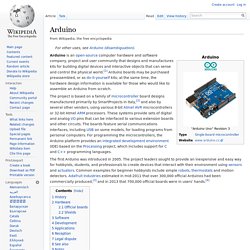
The first Arduino was introduced in 2005. The project leaders sought to provide an inexpensive and easy way for hobbyists, students, and professionals to create devices that interact with their environment using sensors and actuators. Common examples for beginner hobbyists include simple robots, thermostats and motion detectors. Adafruit Industries estimated in mid-2011 that over 300,000 official Arduinos had been commercially produced,[3] and in 2013 that 700,000 official boards were in users' hands.[4] History[edit] Hardware[edit] Official boards[edit] Shields[edit]
Wiring (development platform) Wiring is an open source electronics prototyping platform composed of a programming language, an integrated development environment (IDE), and a single-board microcontroller.
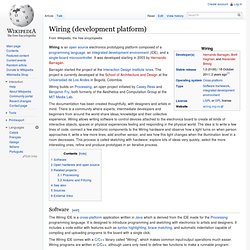
It was developed starting in 2003 by Hernando Barragán. Barragán started the project at the Interaction Design Institute Ivrea. The project is currently developed at the School of Architecture and Design at the Universidad de Los Andes in Bogotá, Colombia. The documentation has been created thoughtfully, with designers and artists in mind. There is a community where experts, intermediate developers and beginners from around the world share ideas, knowledge and their collective experience. Setup() – a function run once at the start of a program which can be used to define initial environment settingsloop() – a function called repeatedly until the board is powered off A typical first program for a microcontroller is to simply blink an LED (light-emitting diode) on and off.
Processing (programming language) Processing includes a sketchbook, a minimal alternative to an integrated development environment (IDE) for organizing projects.
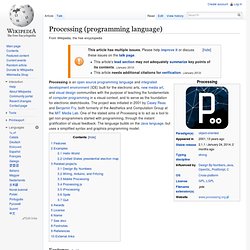
Every Processing sketch is actually a subclass of the PApplet Java class which implements most of the Processing language's features. When programming in Processing, all additional classes defined will be treated as inner classes when the code is translated into pure Java before compiling. This means that the use of static variables and methods in classes is prohibited unless you explicitly tell Processing that you want to code in pure Java mode.
Processing also allows for users to create their own classes within the PApplet sketch. This allows for complex data types that can include any number of arguments and avoids the limitations of solely using standard data types such as: int (integer), char (character), float (real number), and color (RGB, ARGB, hex). The Processing equivalent of a Hello World program is simply to draw a line:[1]
Bionic Arduino – Introduction to Microcontrollers with Arduino. Bionic Arduino is a set of four 3-hour classes in November 2007 hosted by Machine Project and taught by Tod E.
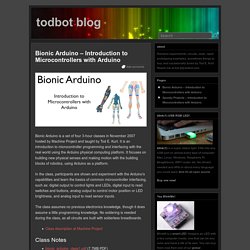
Kurt. It is an introduction to microcontroller programming and interfacing with the real world using the Arduino physical computing platform. It focuses on building new physical senses and making motion with the building blocks of robotics, using Arduino as a platform. In the class, participants are shown and experiment with the Arduino’s capabilities and learn the basics of common microcontroller interfacing, such as: digital output to control lights and LEDs, digital input to read switches and buttons, analog output to control motor position or LED brightness, and analog input to read sensor inputs.
The class assumes no previous electronics knowledge, though it does assume a little programming knowledge. Class description at Machine Project Class Notes. Practical Arduino: News. Modern Device. Make: Arduino. Adafruit Industries, Unique & fun DIY electronics and kits. Welcome. Projects.
News. Seeed Studio Bazaar, Boost ideas, extend the reach. Arduino Shield List. Liquidware : Open Source Electronics. Amarino - "Android meets Arduino" - Home. Arduino. Arduino meets processing - PUSHBUTTON. The Arduino meets Processing project intends to make it as easy as possible for anyone to explore the world of physical computing.
Temperature Sensor + Arduino « DanielAndrade.net. Hello people, it’s been a while since I have posted projects on this website.

This semester was really busy, I didn’t have time to much else, but soon I will have my winter holiday (Here in south our summer holiday is from December to February). Today I am going to show you how to build a simple temperature sensor using one LM35 Precision Temperature Sensor and Arduino, so you can hookup on your future projects. The circuit will send serial information about the temperature so you can use on your computer, change the code as you will. I’m planning to build a temperature sensor with max/min + clock + LCD, and when I get it done, I will post here. Parts: Arduino (You can use other microcontroller, but then you will need to change the code).LM35 Precision Centigrade Temperature Sensor, you can get from any electronic store.
DIY Drones. Welcome to NKC Electronics. Boarduino - Breadboard-compatible Arduino Clone. Wiring. Processing.org. This is Wiring (and Arduino) The Wiring i/o board is a small, cheap standalone computer with many connection capabilities.
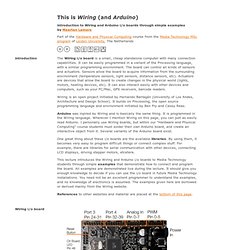
It can be easily programmed in a variant of the Processing language, with a similar programming environment. The board can control all kinds of sensors and actuators. Sensors allow the board to acquire information from the surrounding environment (temperature sensors, light sensors, distance sensors, etc). Actuators are devices that allow the board to create changes in the physical world (lights, motors, heating devices, etc). Arduino Main Board. Description: This is the new Arduino Uno R3.

In addition to all the features of the previous board, the Uno now uses an ATmega16U2 instead of the 8U2 found on the Uno (or the FTDI found on previous generations). This allows for faster transfer rates and more memory. No drivers needed for Linux or Mac (inf file for Windows is needed and included in the Arduino IDE), and the ability to have the Uno show up as a keyboard, mouse, joystick, etc. The Uno R3 also adds SDA and SCL pins next to the AREF. In addition, there are two new pins placed near the RESET pin.
ARDUINO.